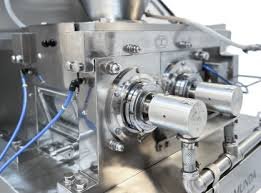A Comprehensive Guide to Roll Compactor Operation and Cleaning

Operation and Cleaning of Roll Compactor: Detailed Explanation
A roll compactor is an industrial machine used to compact materials such as powders or granules into denser forms, usually pellets or flakes. It plays a crucial role in the manufacturing and processing industries, especially in the pharmaceutical, food, and chemical sectors. Proper operation and cleaning of a roll compactor are essential for ensuring its efficiency, longevity, and safe operation.
1. Operation of Roll Compactor
a. Pre-Operation Setup:
Before starting the roll compactor, it’s crucial to check certain parameters and ensure the machine is ready for operation:
-
Material Check: Verify the material’s properties (e.g., moisture content, flowability, and size distribution). These factors influence compaction efficiency.
-
Roll Alignment: Ensure that the rolls are aligned properly. Misalignment can lead to uneven compaction or excessive wear.
-
Feeding System: Ensure the material is being fed properly into the compactor, either via a hopper or conveyor system.
-
Roll Speed and Pressure: Adjust the roll speed and pressure based on the type of material being compacted. Higher pressure is required for harder or denser materials.
-
Lubrication Check: Ensure that the rolls are adequately lubricated to minimize friction and wear.
b. Compaction Process:
The compaction process involves the following stages:
-
Feeding: Material enters the compactor through a feeding system (either gravity-fed or mechanically conveyed).
-
Pre-Compression: The material is pre-compressed before entering the rollers.
-
Compaction: As the material passes through the rollers, it is compressed under high pressure. The rollers may have different designs such as smooth, grooved, or toothed, depending on the desired end product.
-
Product Formation: The compacted material exits the compactor as flakes, sheets, or pellets, depending on the roll design.
-
Cooling: After compaction, the product may need to cool down before further processing or packaging.
c. Safety Considerations:
-
Emergency Stop: Ensure that the machine has an easily accessible emergency stop mechanism.
-
Operator Training: Operators should be well-trained in handling the equipment and understanding its functions, safety measures, and troubleshooting.
-
Routine Checks: Before starting, check for any loose components, damaged parts, or abnormal noises from the machine that may indicate mechanical issues.
2. Cleaning of Roll Compactor
Proper cleaning of the roll compactor is essential to maintain its functionality, prevent cross-contamination, and extend its lifespan. Here’s how to clean the machine:
a. Safety First:
-
Turn Off the Machine: Ensure that the power is turned off, and any energy sources (electricity or air) are disconnected.
-
Wear Protective Gear: Operators should wear gloves, goggles, and any necessary personal protective equipment (PPE).
b. Remove Residual Material:
-
Unload the Machine: Ensure that no material remains inside the compactor.
-
Disassemble Parts: Depending on the machine design, remove parts like hoppers, conveyors, and trays that may have collected material. These parts should be cleaned separately.
c. Cleaning the Rolls:
-
Dry Cleaning: Use a soft brush or air blower to remove dry residues from the rollers.
-
Wet Cleaning: If residues are difficult to remove, use a soft cloth dampened with a mild detergent solution. Avoid harsh chemicals that could damage the rolls.
-
Roll Surface Care: Be gentle while cleaning the rolls to avoid damaging or wearing down the surface. Special cleaning tools may be required for specific roll designs (grooved or smooth).
d. Clean the Feeding and Discharge System:
-
Hopper and Feed Chute: Clean the hopper and feed chute to remove any leftover material that could affect future batches.
-
Discharge Area: Clean any discharge mechanisms like belts or conveyor systems to ensure smooth operation.
e. Lubrication and Maintenance:
-
Re-lubricate the Rolls: After cleaning, reapply lubrication to the rollers to reduce friction and wear during the next operation.
-
Check Bearings and Motors: Inspect the bearings and motors for wear, and clean them if necessary.
-
Replace Damaged Parts: Regularly inspect parts such as seals, belts, and gaskets. Replace any worn or damaged components to prevent further issues.
f. Post-Cleaning Inspection:
-
Check for Damage: After cleaning, inspect the rolls, feeding system, and other components for wear or damage. Regular checks help identify problems early.
-
Ensure No Residue: Make sure no cleaning residues or chemicals remain on the machine to avoid contamination in the next run.
g. Record Keeping:
-
Document Maintenance: Keep records of cleaning and maintenance activities for future reference and audits. This is particularly important in industries where compliance is necessary, such as pharmaceuticals or food processing.
3. Tips for Optimal Operation and Cleaning:
a. Regular Maintenance Schedule:
-
Establish a regular maintenance and cleaning schedule based on the machine’s usage and the material being processed.
b. Avoid Overloading:
-
Overloading the machine can cause unnecessary strain on the motor, rolls, and other components, reducing efficiency and lifespan.
c. Monitor Temperature and Humidity:
-
Ensure that temperature and humidity conditions are within the optimal range for the material being compacted.
d. Preventive Maintenance:
-
In addition to cleaning, perform routine checks and preventive maintenance to avoid unexpected breakdowns.
e. Follow Manufacturer Guidelines:
-
Always follow the manufacturer’s guidelines for operation and maintenance to ensure optimal performance and safety.
Conclusion
Operating and cleaning a roll compactor involves careful attention to detail and following proper procedures to ensure the machine runs efficiently and remains in good working condition. By properly setting up the machine, monitoring the compaction process, and thoroughly cleaning after use, you can prolong the machine’s life and ensure the quality of the product produced. Regular maintenance and cleaning are key to avoiding breakdowns and ensuring the safety of the operation.
🎓 Discover one of the best Pharmaceutical Production courses available — click below to explore the course that’s shaping future Production skills.
#CompactionProcess, #CompactorMaintenance, #IndustrialCleaning, #MachineryMaintenance, #RollCompactor, #RollCompactorCleaning, #RollerCleaning
Posted onMay 6, 2025

